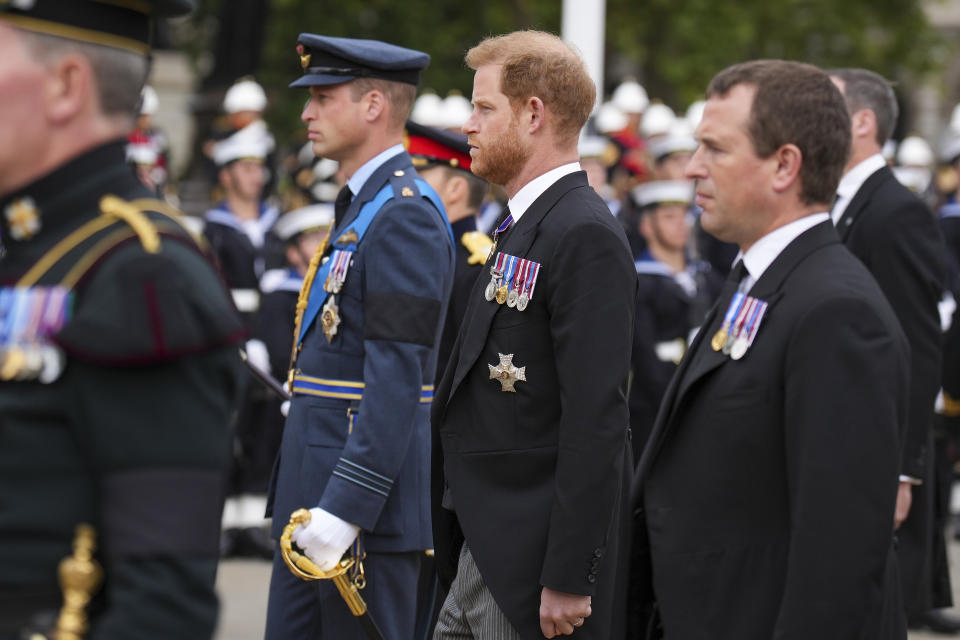King Charles and senior members of the Royal Family accompanied the Queen’s coffin along its final procession through London during the ceremonies surrounding her funeral.
While Charles and the Prince of Wales were dressed in their military uniform, Prince Harry was in a mourning suit, even though he served two tours of Afghanistan while in the Army.
The Duke of York was also in civilian clothes, despite having served in the Royal Navy as a helicopter pilot and instructor and as the captain of a warship.
The protocol around the dress code for some of the royals has been a high-profile talking point throughout the mourning period.
Why Harry wasn’t in uniform
Harry, the Duke of Sussex, served for 10 years in the army, including two tours in Afghanistan, and has been seen wearing military uniforms at previous public events.
Prince William, was commissioned as a lieutenant in the army and served for five months as the leader of an armoured reconnaissance unit based in Dorset.
Watch: Prince Harry blocked from wearing uniform while mourning Queen
He also spent two years working as a helicopter pilot for the RAFs Search and Rescue force and later with the East Anglian Air Ambulance but he never served in active combat.
But when it came time to appear behind the Queen’s coffin during her funeral procession, Prince William was given the right to wear a military uniform but Prince Harry was not.
That’s because only working members of the Royal Family have been allowed to wear a military uniform while at public events commemorating the Queen.
This has excluded Harry as well as Prince Andrew.
Read more: Queen’s funeral: How to watch Monday’s ceremony at Westminster Abbey
Harry lost his honorary military titles when he stepped down as a working royal in 2020.
Andrew was stripped of them in early 2022 amid the scandal about his relationship with paedophile billionaire Jeffery Epstein.
The Duke of Sussex retains the current rank of captain but he lost the title of Captain General of the Royal Marines after he left the Royal Family.
As the funeral procession moved passed the Cenotaph in central London, the royals in uniform saluted the monument, while those in civilian dress bowed their heads.
Read more: Devoted royal fan travels 11,000 miles for Queen’s funeral and procession
Although there has been speculation Harry has been unhappy he has been denied the right to wear a military uniform, a spokesperson for the Duke denied this last week.
The spokesperson said the Duke “will wear a morning suit throughout events honouring his grandmother”.
“His decade of military service is not determined by the uniform he wears, and we respectfully ask that focus remain on the life and legacy of Her Majesty Queen Elizabeth II.”
Harry was allowed to wear military uniform during a vigil for the Queen by her grandchildren on Saturday at her lying-in-state – just as Prince Andrew was.
However, there were reports he was upset after the ER initials – traditionally worn by those in service of the monarch – were removed from the epaulettes on his uniform.
Why was an exception made for Prince Andrew at the lying-in-state?
Although Andrew has largely been seen in civilian clothes during the public events surrounding the Queen, he was given an exception for the final vigil of the Queen in Westminster Hall on Friday night.
Known as the Vigil of the Princes, all of the Queen’s children stood watch over her coffin at the end of her lying-in-state.
The exception for Andrew is believed to have been made as a “special mark of respect” to the Queen — a decision that sparked a backlash in some quarters among those angry the disgraced Duke of York was being accorded such an honour despite having had his royal titles stripped in disgrace.
King Charles’ uniform
The King wore the Royal Navy No 1 tailcoat with sword, the collar of the Order of the Garter, Order of the Thistle Sash, Order of Merit neck order, Garter Star and Thistle Star.
He also wore full-size medals including the Queen’s Service Order (New Zealand), Coronation Medal, Silver Jubilee Medal, Golden Jubilee Medal, Diamond Jubilee Medal, Platinum Jubilee Medal and a Naval Long Service Good Conduct (LSGC) (three x Additional Service Bars).
Other medals included Canadian Forces Decoration (three x Additional Service Bars), The New Zealand Commemorative Medal, and The New Zealand Armed Forces Award.
Charles had a six-year military career, mainly flying for the Royal Navy.
Prince William’s uniform
The Prince of Wales wore the RAF No 1 uniform with the Garter Sash with RAF Pilot Wings and the Garter Star Chest Order.
He also wore the Gold, Diamond and Platinum Jubilee Medals.
William spent seven years in the military, including more than three years as a search and rescue pilot.




